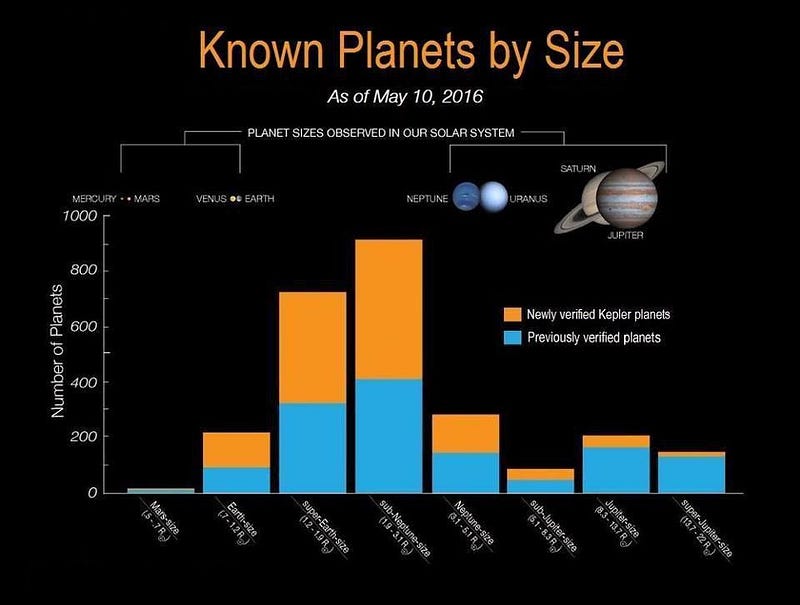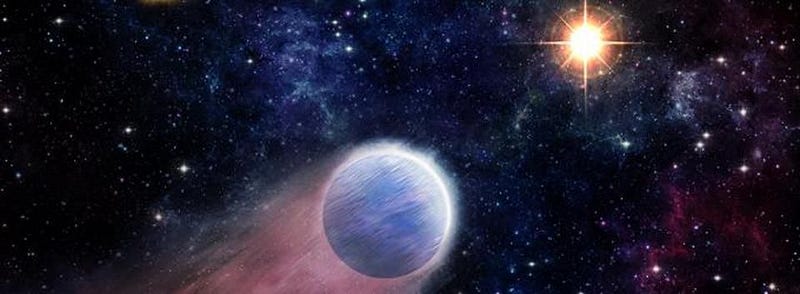Sorry, Super-Earth Fans, There Are Only Three Classes Of Planet

And super-Earth, mini-Neptunes, and super-Jupiters aren’t among them. You’ll be surprised to learn why.
Just 30 years ago, if you had asked an astronomer if there were planets around other stars beyond the Sun, they couldn’t tell you for certain. Although all the theories about planet formation indicated that they should exist around many stars, if not most of them, we had no evidence of planets beyond the Solar System. So we did the most natural thing you can imagine: we assumed others were like our own, with rocky worlds in the inner portions and gas giants in the outer reaches. Over the ensuing decades, we began discovering that our assumptions were gravely mistaken: practically all stars have planets; worlds of all sizes could appear anywhere in a solar system; there were many planets even larger than Jupiter; and most worlds were larger than Earth but smaller than Neptune. Yet, despite all we’ve learned, there seem to be only three classes of planet out there: Terran worlds, Neptunian worlds, and Jovian worlds.

This is likely not what you’ve heard before, since this isn’t how astronomers have been classifying the planets they’ve been finding. Owing to two major methods:
- The radial velocity (or stellar wobble) method, where the mass of a planet is inferred by the periodic orbital motion its star is seen to experience,
- and the transit method (used by NASA’s Kepler satellite), where a planet passes in front of a star relative to our line-of-sight, blocking some of its light,
we’ve been able to measure either the mass or the radius of a large number of planets. Kepler, in particular, is outstanding at measuring an exoplanet’s radius. When we classified them, we found something exciting and surprising: the majority of the planets in the Universe weren’t like the ones in our Solar System.

While rocky, Earth-sized worlds — and slightly larger and slightly smaller rocky worlds — were common, as were Neptune-and-Jupiter sized worlds, there was a third class of planet that was the most common of all. In between the size of Earth and Neptune lied a possibility we had overlooked: a super-Earth (or mini-Neptune) world. As it turned out, there were more super-Earths than any other type. It led many to wonder why our Solar System didn’t have one of these super-Earth-like planets, and whether some catastrophe or rarity happened in our early history to leave us with the results we have today.

The possibilities were intriguing but frustrating, including:
- That early super-Earths formed, but didn’t survive, perhaps getting ejected as the giant planets migrated.
- That the entire inner Solar System was erased before Jupiter moved outwards, and the rocky worlds are so small because they formed late, after most of the material was gone.
- Or that our massive gas giants and the Sun gobbled up the early planet-forming material for themselves, eliminating the possibility of a super-Earth.
But all of this speculation made an important assumption that isn’t necessarily correct: that what we’re calling super-Earths and mini-Neptunes are actually distinct classes of planet from what we have in our Solar System. Is that assumption any good, though?

The way you tell is by looking at the data that you have. If you want to be considered a planet, everyone agrees that you need to have enough mass to pull yourself into hydrostatic equilibrium: a sphere if you’re not rotating, a more ellipsoidal shape if you are. We can imagine a lot of different possibilities for these worlds, including:
- whether they’re rocky or not,
- whether they have atmospheres or not,
- whether their surfaces have frozen over or not,
- whether they have large, hydrogen-and-helium gas envelopes around them,
- whether their cores are significantly compressed due to gravitation,
- and whether they’re beginning to fuse light elements into heavier ones inside of them.
Simple yes-or-no answers to these questions might be relevant not only for the potential habitability of a world, but also for understanding how many types are scientifically reasonable to classify these worlds into.

But rather than speculate with the Kepler data, scientists Jingjing Chen and David Kipping came up with a new, intriguing and compelling way of classifying these worlds based on the data alone. By plotting out only the planets that we had measured both the mass and radius of, they were able to identify where there were steady relationships between worlds (indicating similarities), and where there were changes in relationships (indicating changes or transitions). What they found showed us that we’ve been looking at the “problem” all wrong.

As their research (and the above graph) shows, there are only three different types of world that exist! According to their classification schemes, there are:
- Terran worlds — these are worlds akin to the rocky worlds in our Solar System. They may have oceans, ices, and/or atmospheres, but don’t have a hydrogen/helium envelope around them.
- Neptunian worlds — these are planets akin to Saturn, Uranus and Neptune, and are dominated by a large atmosphere of hydrogen, helium, and other atoms/molecules that are easily boiled-off. They may have rocky interiors, but they obey a different mass/radius relationship than the Terran worlds.
- Jovian worlds — akin to Jupiter, these worlds are so massive that they begin to compress on the inside; as you add more mass, their radius shrinks. This effect, of gravitational self-compression, is why Jupiter is only about 20% larger than Saturn, but is three times as massive.
And that’s it. If you get more massive than that, you’ll start fusing light elements into heavier ones in your core, and become a full-blown star.

Now, there are some extremes likely to be out there, that represent small exceptions to this rule. There are Neptunian or possibly even Jovian worlds that have been so thoroughly blasted by either a star or another astrophysical source that their atmospheres have been stripped away, and all that remains is a rocky, Terran-world-like core. There are Jovian worlds so massive that they start the process of deuterium-burning, becoming a type of failed star known as a brown dwarf. And there may be worlds in the transition zones, either between Terran/Neptunian or Neptunian/Jovian, that maybe have features of both classes of world, depending on various factors like temperature or evolutionary history.

What’s really interesting is how the mass/radius relationship changes for these three different classes of world. Up to about double the Earth’s mass, or a size just ~25% larger than Earth’s radius, you have an opportunity to be Earth-like, with thriving life on the surface. Beyond that, you’ll have an enormous hydrogen/helium envelope, and be much more akin to Neptune, Uranus or Saturn. In other words, what we’ve been classifying as “super-Earths” aren’t anything like Earth at all, but are instead gas giant worlds, expected to be wholly inhospitable to life on their surfaces.

Chen and Kipping come to this very conclusion in their paper, where they answer the question of “where is our Solar System’s super-Earth?” as follows:
The large number of 2–10 [Earth mass] planets discovered is often cited as evidence that Super-Earths are very common and thus Solar System’s makeup is unusual… However, if the boundary between Terran and Neptunian worlds is shifted down to 2 [Earth masses], the Solar System is no longer unusual. Indeed, by our definition three of the eight Solar System planets are Neptunian worlds, which are the most common type of planet around other Sun-like stars.
In this classification, the answer becomes clear: Earth-sized is the right size for potential long-term life. Much smaller, and it’s hard to hold onto a rich, life-supporting atmosphere; much larger, and it’s too easy to hold onto a life-crushing hydrogen/helium envelope.

There are a few planets out there that we’ve discovered so far, such as Kepler-438b, Kepler-186f, Proxima b, and the TRAPPIST-1 worlds, that might have the right combination of mass-and-radius to support life. But most of what we’ve been calling “potentially habitable worlds” out there are simply too large in radius, and hence, with a crushing atmosphere full of volatiles, to be a candidate for life-as-we-know-it in any way at all. There are only three classes of planets out there, the Terran worlds, Neptunian worlds, and Jovian worlds, that make any sort of physical sense. What we’ve been calling super-Earths are just Neptunian worlds that are somewhat smaller than what we find in our Solar System, and they turn out to be the most common type of planet out there. With three Neptunian worlds in our own backyard, we’re not missing anything after all.
Ethan Siegel is the author of Beyond the Galaxy and Treknology. You can pre-order his third book, currently in development: the Encyclopaedia Cosmologica.





